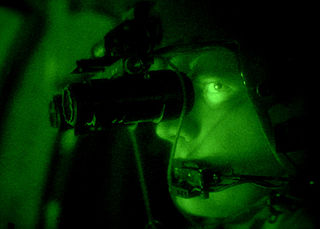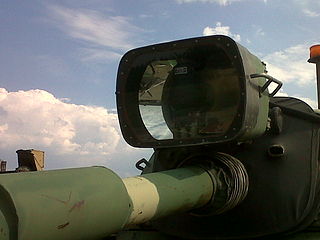
Night vision is the ability to see in low-light conditions, either naturally with scotopic vision or through a night-vision device. Night vision requires both sufficient spectral range and sufficient intensity range. Humans have poor night vision compared to many animals such as cats, dogs, foxes and rabbits, in part because the human eye lacks a tapetum lucidum, tissue behind the retina that reflects light back through the retina thus increasing the light available to the photoreceptors.

A night-vision device (NVD), also known as a night optical/observation device (NOD) or night-vision goggle (NVG), is an optoelectronic device that allows visualization of images in low levels of light, improving the user's night vision. The device enhances ambient visible light and converts near-infrared light into visible light which can be seen by the user; this is known as I2 (image intensification). By comparison, viewing of infrared thermal radiation is referred to as thermal imaging and operates in a different section of the infrared spectrum. A night vision device usually consists of an image intensifier tube, a protective housing, and may have some type of mounting system. Many NVDs also include a protective sacrificial lens, mounted over the front lens (ie. objective lens) on NVDs to protect the latter from damage by environmental hazards, and some can incorporate telescopic lenses. The image produced by an NVD is typically monochrome green, as green was considered to be the easiest color to look at for prolonged periods in the dark. Night vision devices may be passive, relying solely on ambient light, or may be active, using an IR (infrared) illuminator to visualize the environment better.
An image intensifier or image intensifier tube is a vacuum tube device for increasing the intensity of available light in an optical system to allow use under low-light conditions, such as at night, to facilitate visual imaging of low-light processes, such as fluorescence of materials in X-rays or gamma rays, or for conversion of non-visible light sources, such as near-infrared or short wave infrared to visible. They operate by converting photons of light into electrons, amplifying the electrons, and then converting the amplified electrons back into photons for viewing. They are used in devices such as night-vision goggles.
The Special Operations Peculiar MODification (SOPMOD) kit is an accessory system for the M4A1 carbine, CQBR, FN SCAR Mk 16/17, HK416 and other weapons used by United States Special Operations Command (USSOCOM) special forces units, though it is not specific to SOCOM. The kit allows US Special Operations Forces personnel to configure their weapons to individual preferences and customize for different mission requirements.
Johnson's criteria, or the Johnson criteria, created by John Johnson, describe both spatial domain and frequency domain approaches to analyze the ability of observers to perform visual tasks using image intensifier technology. It was an important breakthrough in evaluating the performance of visual devices and guided the development of future systems. Using Johnson's criteria, many predictive models for sensor technology have been developed that predict the performance of sensor systems under different environmental and operational conditions.

The Type 98 (PF-98) is a 120mm unguided anti-tank rocket system developed by Norinco for the People's Liberation Army as a successor to the Type 65 and Type 78 recoilless guns. It is also known by its nickname, "Queen Bee". It can be equipped with a firing control system which can calculate and adjust for projectile drop before the rocket fires.

Teledyne FLIR LLC, formerly FLIR Systems Inc,, a subsidiary of Teledyne Technologies, specializes in the design and production of thermal imaging cameras and sensors. Its main customers are governments and in 2020, approximately 31% of its revenues were from the federal government of the United States and its agencies.

The AN/PVS-14 Monocular Night Vision Device (MNVD) is in widespread use by the United States Armed Forces as well as NATO allies around the world. It uses a third generation image intensifier tube, and is primarily manufactured by Litton Industries and Elbit Systems of America. It is often used 'hands free' using a head harness or attached to a combat helmet such as the PASGT, MICH TC-2000 Combat Helmet, Advanced Combat Helmet, Marine Lightweight Helmet or IHPS. It can also be used as a weapons night sight. In addition, it was part of the equipment fielded in the U.S. Army's Land Warrior program. Morovision Night Vision was the law enforcement distributor of the NEPVS-14 for ITT.
Infrared vision is the capability of biological or artificial systems to detect infrared radiation. The terms thermal vision and thermal imaging, are also commonly used in this context since infrared emissions from a body are directly related to their temperature: hotter objects emit more energy in the infrared spectrum than colder ones.

The Type 63A is an amphibious light tank upgraded from the Type 63, designed for river-crossing operations at inland rivers and lakes. Its industrial designation is WZ213.

AN/PVS-4 is the U.S. military designation for a specification of the first second generation passive Night vision device.
Akrep ("Scorpion") is a Turkish infantry mobility vehicle developed by Otokar Otobus Karoseri Sanayi AS. The first prototypes were completed in May 1993 and the first vehicles came off the production line in June 1994. In addition to light reconnaissance, the vehicles were used for escort, perimeter control, counterinsurgency, and light attack. The Akrep represented the latest offering in Otokar's portfolio of light vehicles for both civilian and military markets.

The AN/PSQ-20 Enhanced Night Vision Goggle (ENVG) is a third-generation passive monocular night vision device developed for the United States Armed Forces by ITT Exelis. It fuses image-intensifying and thermal-imaging technologies, enabling vision in conditions with very little light. The two methods can be used simultaneously or individually. The ENVG was selected by the US Army's Program Executive Office Soldier as a supporting device for the Future Force Warrior program in 2004, and is intended to replace the older AN/PVS-7 and AN/PVS-14 systems. Although more expensive and heavier than previous models, US Special Forces began using the goggles in 2008 and the US Army's 10th Mountain Division began fielding the AN/PSQ-20 in 2009. Improvements to the goggles have been attempted to make them lighter, as well as enabling the transmission of digital images to and from the battlefield.

The M2010 Enhanced Sniper Rifle (ESR), formerly known as the XM2010 and M24 Reconfigured Sniper Weapon System, is a sniper rifle developed by PEO Soldier for the United States Army. It is derived from and replaced the M24 Sniper Weapon System, and was designed to give snipers longer range in the mountainous and desert terrain of the War in Afghanistan. After winning a competitive bidding process, Remington was awarded the production contract for up to 3,600 weapons. The Army had anticipated sending the upgraded weapons to deployed snipers in late 2010, but later expected fielding would happen in January 2011. The M2010 fires .300 Winchester Magnum (7.62×67mm) ammunition, which offers about 50 percent more effective range than the M24's 7.62×51mm NATO. This chambering to dimensionally larger cartridges is possible because the M24 was designed to use the "long action" bolt version of the Remington 700 receiver for cartridges up to 3.34 inches (84.84 mm) in overall length.
The AN/PVS-5 is a dual-tube night-vision goggle used for aviation and ground support. It uses second-generation image-intensifier tubes. The United States Army still has PVS-5 on supply but are very rarely used. The AN/PVS-5 is based on the SU-50 which was a first-generation night-vision goggle adapted by the United States Air Force in 1971. From 1972 until 1990 the AN/PVS-5 was the mainstay in US Army night vision for aviation. The AN/PVS-5C was not approved for flight because of its auto-gated feature causing the goggle to shut off in bright light. For ground troops the AN/PVS-5 was the sole night-vision goggle until the adaptation of the improved AN/PVS-7. Photographic evidence from Operation Eagle Claw shows US military personnel at Desert One in Iran using in the AN/PVS-5 NVGs.

Battlefield illumination is technology that improves visibility for military forces operating in difficult low-light conditions. The risks and dangers to armies fighting in poor light have been known since Ancient Chinese times. Prior to the advent of the electrical age, fire was used to improve visibility on the battlefield.

The AN/PVS-17 Miniature Night Sight (MNS) is a compact, lightweight and high performance night vision weapon sight in wide use by the US Army Special Forces and USMC. The AN/PVS-17 is a Generation III Night Vision Device and uses the OMNI IV MX 10160 3rd generation image intensifier tube and can also be used as a handheld observation device. The designation AN/PVS translates to Army/Navy Portable Visual Search, according to Joint Electronics Type Designation System guidelines.

The AN/PSQ-42 Enhanced Night Vision Goggle-Binocular (ENVG-B) is a third-generation passive binocular night vision device developed for the United States Army by L3Harris. It combines dual tube image-intensifying (I²) and thermal-imaging technologies into a single goggle, enabling vision in low-light conditions. The two methods can be used individually or simultaneously in a fused mode. The ENVG-B is intended to be issued to the dismounted combat arms soldiers within the Army's Brigade combat teams (BCT), and so far over 10,000 have been issued to several BCT's within the 1st Infantry Division, 2nd Infantry Division, 25th Infantry Division, 82nd Airborne Division and 101st Airborne Division. The US Marine Corps has also purchased 3,100 ENVG-B units.












